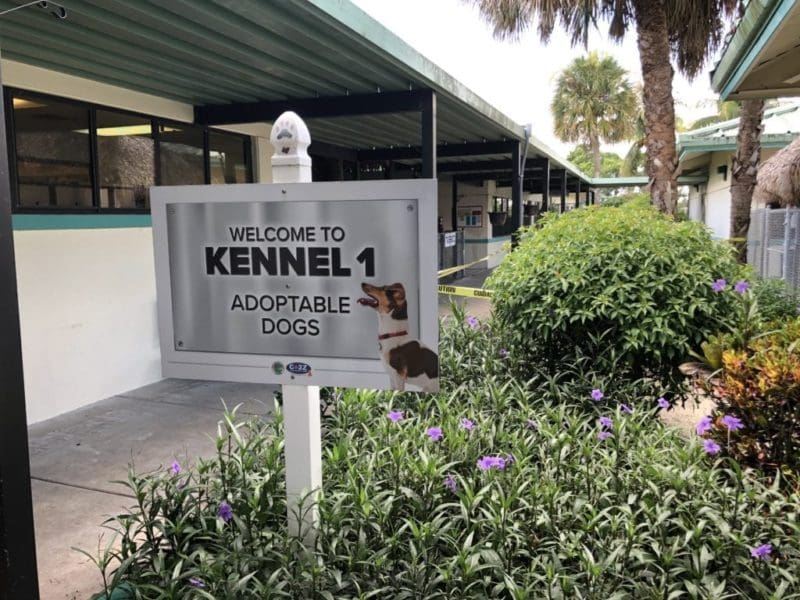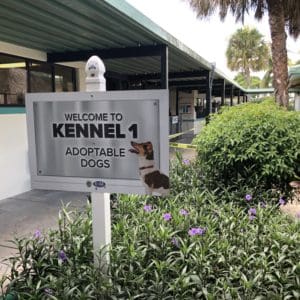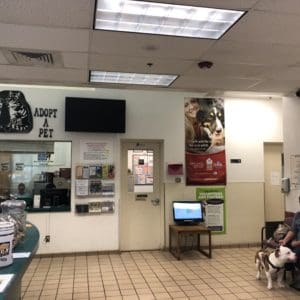Palm Beach County Animal Care & Control
7100 Belvedere Road, West Palm Beach, Florida 33411
WEST PALM BEACH— Many municipal animal shelters limit intakes to dogs and cats. But at Palm Beach County Animal Care and Control in West Palm Beach, Florida, the open door admission policy extends to other animals, even livestock. “I was notified yesterday to be prepared for a very large neglect case coming in with horses,” said executive director Dianne Sauve, who has served in her current role since 2002.
Founded in 1969, Animal Care and Control expanded five years later, becoming part of wealthy Palm Beach County’s Department of Public Safety. Today, the 14-acre facility, whose roster of adopters includes billionaire heiress and equestrian Georgina Bloomberg, serves almost 40 different municipalities.
There are about 110 full-time employees, including four veterinarians [there is an opening for a fifth veterinarian, but a shortage of veterinarians affecting shelters throughout South Florida has made efforts to fill the position challenging] and one certified trainer, all of whom are employed by Palm Beach County. In addition, the shelter, whose population of dogs at capacity totals about 350, has about 100 active and regular volunteers.
Faster, Easier Adoptions
Sauve says her top priority at the shelter’s helm has been to adopt out as many animals as possible:
“We do our best not to put up barriers for adoption,” she said. “You fill out an application, we screen you through our extensive DNA [“Do Not Adopt”] list and if the dog has been examined, vaccinated, microchipped and spayed/neutered, you are good to go. We find that the tighter we hold onto animals, the fewer go out the door.”
The shelter’s adoption policies are more user-friendly than most. For example, while many shelters will not “hold” a dog overnight, PBCACC will do so for several days, provided the adopter pays the adoption fee. And, the shelter is able to arrange a “meet and greet” with a family’s other pets, although, unlike many shelters, it does not require such a meeting. Finally, if an animal is adopted and circumstances change for either the adopter or the dog, the animal may be returned to the shelter at any time.
Transparency, But Only Each Month
Palm Beach County ACC publishes on its website a single monthly report of detailed outcome data, including adoptions, returns to owners, deaths and euthanasia’s. However, it does not publish data over time, extending beyond the current month. In other words, the shelter does not publish historical data and, thus, the data provided on the website is not sufficient to spot trends or compare outcomes over time with those of other shelters. For example, the website of the New York City Animal Care Center publishes both monthly and annual outcome data logs extending back to 2014, inviting the public to see both historical and real-time data.
Palm Beach County Animal Care and Control provided The Canine Review with five years of outcome data and Sauve says such data is available to anyone who asks for it. Asked why the data is not published on the shelter’s website, and how the shelter reconciles its statement about “transparency” with a single month of data being made available, Sauve, the director, told The Canine Review the five year reports are independently produced by the Peggy Adams Animal Rescue League from data provided by Palm Beach County ACC. Sauve says that there are plans to publish more data to the Palm Beach County ACC website within the next year.
Beating the Heat
When The Canine Review visited in mid-July, the ambient temperature at noon was 91 degrees. Sauve noted that soaring summer temperatures in the unairconditioned kennels have been a major struggle for the South Florida shelter.
Although Sauve has been able to remedy the situation partially with a portable air conditioning system that pumps cold air directly into the kennels through large tubes in windows, the system does not circulate air adequately. The result has been a tripling in the number of dogs suffering from respiratory illnesses such as bronchitis and influenza.
Behavior and Enrichment
Dogs with behavioral challenges receive special attention from the shelter’s certified trainer and behaviorist Stephanie Moore. Moore, who has worked at the shelter in her current role since June, 2019, keeps detailed logs of her behavioral observations during daily play groups of all dogs at the shelter. Moore makes these logs available to shelter staff as well as to potential adopters.
Moore has 20 years of animal welfare experience, most recently as the assistant director of Louisville Metro Animal Services in Kentucky. She insists that PBCACC is one of the best she’s seen.
“The size of our dog kennels are [sic] amazing, as our animals don’t have to worry about eliminating near their food or where they sleep,” said Moore. “Our play yards are the best I’ve come across so far. They are a wonderful enrichment tool for the dogs and really help them adjust to their time in a shelter. They can run and play and be dogs.”
Shelter Services
The shelter does not offer a formal wellness clinic for the general public although it does offer low-cost spay/neutering services by appointment.
Rabies vaccinations and microchipping services are available to the public seven days per week with no appointment necessary, although there is usually a wait.
Shelter Dollars
As a government agency, the shelter has an annual budget approved by a seven-member Board of County Commissioners. According to FY2018-19 data supplied to The Canine Review by Palm Beach County’s Public Safety Department, the ACC’s total revenue was $3,094,480 with expenses of $11,274,818, the primary expense being staff salaries and benefits. This means that county residents paid $8,180,338 in property taxes to support the shelter. The complete budget document can be viewed here, on page 247 but the shelter’s own website does not provide a breakdown for each division within any single department.
2018 Number of full-time employees: 110
2018 Number of active volunteers:
2018 Total number of dogs at max capacity:
Staff to Animal Ratio:
Total Expenses: $11,274,818
Total Revenue: $3,094,480 + County residents paid $8,180,338 in property taxes to support the shelter
Using ASPCA’s formula, The Canine Review calculated PBCACC’s 2018 Live Release Rate as follows: Live Outcomes [1707 (adopted) + 1089 (reunited with owners) + 1410 (transferred out) = 4206 / All Intakes = [4867] = 4206/4867
= 2018 ASPCA Live Release Rate: 86%
Using ASPCA’s formula, The Canine Review calculated PBCACC’s 2017 Live Release Rate as follows: Live Outcomes [1566 (adopted) + 1219 (reunited with owners) + 1562 (transferred out)] =4347 / Intakes = [5165] = 4347/5165
= 2017 ASPCA Live Release Rate: 84%
The Canine Review calculates a shelter’s annual “Death Rate” by diving the total number of dogs who died in the shelter’s care (including dogs who died due to owner requested euthanasia, dogs who went missing or who were stolen) by all dogs with final dispositions, including all live outcomes as well as those dogs who died.
Number of dogs who died while in shelter’s care:
2018: 654 2017: 672
Death Rate = Total Deaths / All Outcomes
2018: 654/4860 = 13% 2017: 672/5019=13%
The Canine Review calculated PBCACC’s 2018 Death Rate = [14 (died/lost in care) + 640 Euthanasia = 654 total deaths] divided by [1707 adoptions+1089 returns to owners+14 died in shelter care+1410 transfer to other organizations+640 euthanasia=4860] = 654/4860=
2018 Death Rate: 13%
The Canine Review calculated PBCACC’s 2017 Death Rate to be [total deaths] / [total number of dogs with final outcomes, dead or alive] = [18 (died/lost in care) + 654 (euthanasia) = 672 deaths divided by//// [1566 adoptions +1219 reclaimed+18 died/lost+1562 transfer out+654 shelter euth =5824-600-205] = 672 deaths/5019 outcomes=
2017 Death Rate: 13%
Alternate Live Release Rate Formula (focused on outcome): All Live Outcomes / All Outcomes, including those who died, went missing, were euthanized by owner request, and those remaining in shelter
2018 = 4206/[1707 adoptions+1089 reunited with owners +14 died in shelter care+1410 transferred out+640 euthanasia=4860] = 4206/4860=
2018 Live Release Rate 2: 86.5%
2017 Live Release Rate 2: = 4142/5019= 82.5%
INTAKE POLICIES
- Open Admission
- Admits horses, cows, pigs, rabbits, birds, in addition to dogs and cats
HOUSING AND ENRICHMENT
- Number of dogs when shelter is at max capacity:
- Do all dogs have their own kennels or do they share space?
- Do kennels have natural light?
- Are dogs exposed to the elements or do all kennels have AC and heat? No AC
- full-time, certified trainer(s) on staff? Y
- all dogs out of kennels daily?
- daily morning playgroups?
- what’s the room temperature (if kennels are indoors) on day of TCR visit?
- what’s the temperature outside if kennels are outdoors or exposed to elements 90
- Sound abatement e.g. classical music protocol?
- efforts to decrease stress in shelter environment?
- Kennels well-maintained? Clean?
- Special programs, activities for dogs? Nosework? Reiki? Opportunities for therapy work? Stuffed Kong treats? Treadmills? Swimming? Running? Field trips?
ADOPTION POLICIES
- Application?
- Universal requirements to adopt a dog?
- Landlord reference check required?
- Vet reference check required if applicable?
- Other references required?
- meet and greet with all members of household required?
- meet and greet with all household pets required?
- will you hold a dog for 24hrs to allow time for someone to decide
- do you allow try-outs
- do you refund in full if adoption doesn’t work out
- do you take any dog back at any time if adopter’s situation changes
- do you follow-up? phone? email? home visit?
SHELTER MEDICINE AND SURGERY
- Veterinarian(s) full-time on staff: 4
- Medical services provided to dogs at the time of admission:
- Medical services available to general public:
- Subsidized or covered health costs for adopted dogs:
- Veterinary facilities and equipment on site? OR? Ultrasound? EKG? 24/7?
7100 Belvedere Road, West Palm Beach, Florida 33411





